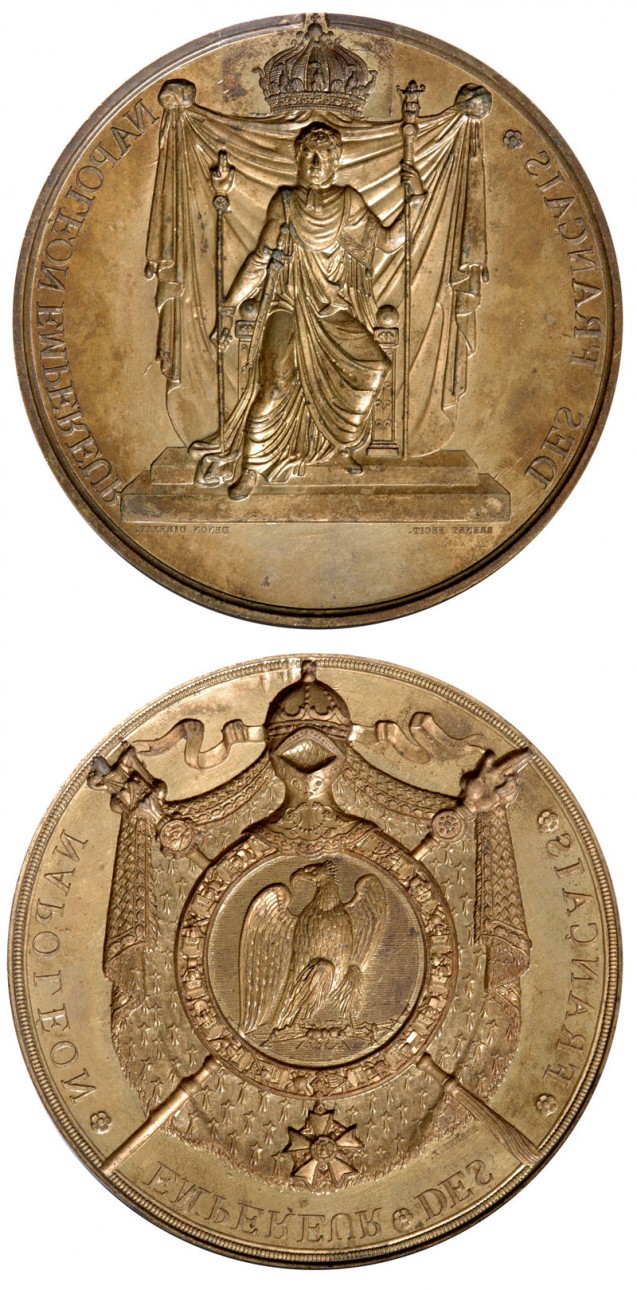The matrices of the Imperial Seal (consisting of a seal and a counter-seal) were made in 1805 by the engraver Nicolas-Guy-Antoine Brenet ( 1770-1846 ) and edited by Vivant Denon (1747-1826), Director of the Musée Napoléon.
The Law on the State Seal was promulgated on 16 Pluviôse XIII (5 February 1805):
“Article 1. The state seal shall bear, as a model, the effigy of the Emperor sat on his throne, clothed in imperial robes , the crown on his head, holding the sceptre and hand of justice, on one side; and the imperial eagle crowned, resting on lightning, on the other side, according to the example attached below.
2. The seal of all authorities shall bear the Imperial Eagle as a rule , as it will form one side of the Great Seal of the State. As a caption, it shall bear the name of the public authority by which it will be used.”
Thus, according to the law of February, 1805, the seal (top image) shows the Emperor in Majesty, sitting on his throne, wearing a laurel wreath, holding the sceptre of Charlemagne and the hand of justice, and carrying the sword at his belt, in front of a background drapery surmounted by the imperial crown. The counter- seal (at the bottom ) bears the coat of arms of the Empire, the imperial eagle holding the lightning in its talons, surrounded by the large collar of the Légion d’Honneur and resting on sceptre and hand of justice intertwined. The whole is placed on the imperial mantle, scattered with bees, and topped with an open helmet.
On the seal and on the counter-seal, one can read one same formula: NAPOLÉON EMPEREUR DES FRANÇAIS (NAPOLEON EMPEROR OF THE FRENCH).
The decree of 17 March, 1808, provided for the creation of a new seal to validate titles of nobility. he had to wear the caption SCEAU IMPÉRIAL DES TITRES (IMPERIAL SEAL OF TITLES). Finally, only the counter-seal was changed, announcing the title of the Emperor: NAPOLEON EMP. DES FRANÇAIS ROI D’ITALIE PROTECTEUR DE LA CONFEDERATION DU RHIN (NAPOLEON EMP. of the FRENCH, KING OF ITALY, PROTECTOR OF THE CONFEDERATION OF THE RHINE), and marked SCEAU IMPal DES TITRES (IMPal SEAL OF TITLES) (nobility titles).
The matrices/moulds of the seal and its counter-seal were destroyed on 14 October, 1814, at the Chancellery (Place Vendôme) in the presence of the Chancellor of Louis XVIII, Charles -Henri Dambray (1760-1829). The ceremony of “obliteration and distortion” depriving Napoleon of his Imperial Seal upon his return to the throne during the Hundred Days, a new seal (representing Napoleon sitting and Napoleon’s profile) was made indeed (Brenet was paid by Louis XVIII’s government) but the seal was never used.
In the Senatusconsultum of 28 Floreal, Year XII (18 May, 1804), Article 40 stated that the High Chancellor of the State (Eugène de Beauharnais (1781-1824) appointed on 31 January, 1805) held the position of Chancellor for the Promulgation of Treaties of Peace and Alliances, and for Declarations of War. Article 41 indicated that the High Chancellor of the Empire (Jean-Jacques-Regis Cambacérès (1753-1824), appointed on 18 May, 1804) acted as Chancellor for the Promulgation of Organic Senatusconsulta and for laws and official acts at the Imperial Palace. On 1 March, 1808, the Council for the Seal of [Nobility] Titles was created, chaired by Cambacérès (with the assistance of three senators, two members of the State Council, a prosecutor and a general secretary).
Irène Delage
24 February, 2014
(Translation Lucie Louvrier)
Our thanks go to Anne de Chefdebien, curator of the National Museum of the Légion d’Honneur in Paris, for the information she kindly provided us with regarding this presentation.
These seals were on show as part of the exhibition Napoleon, His Life, His Legend, in Astana (Kazakhstan), prolonged until 9 March, 2014.


